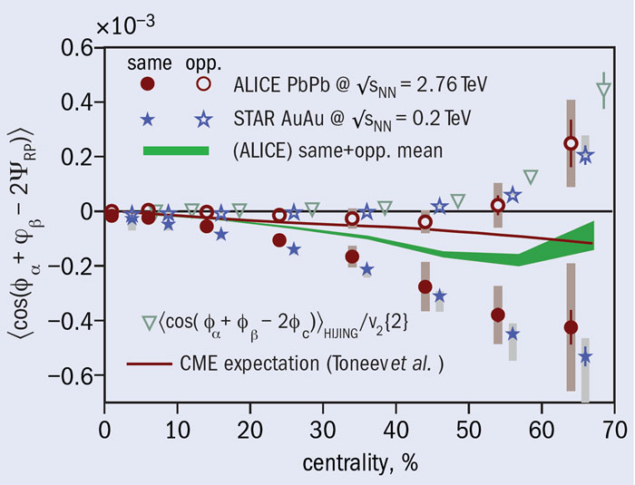The symmetries of parity (P) and its combination with charge conjugation (C) are known to be broken in the weak interaction. However, in the strong interaction the P and CP invariances are respected – although QCD provides no reason for their conservation. This is the “strong CP problem”, one of the remaining puzzles of the Standard Model.
The possibility of observing parity violation in the hot and dense hadronic matter formed in relativistic heavy-ion collisions has been discussed for many years. Various theoretical approaches suggest that in the vicinity of the deconfinement phase transition, the QCD vacuum could create domains – local in space and time – that could lead to CP-violating effects. These could manifest themselves via a separation of charge along the direction of the system’s angular momentum – or, equivalently, along the direction of the strong, approximately 1014 T, magnetic field that is created in non-central heavy-ion collisions and perpendicular to the reaction plane (i.e. the plane of symmetry of a collision, defined by the impact-parameter vector and the beam direction). This phenomenon is called the chiral magnetic effect (CME). Fluctuations in the sign of the topological charge of these domains cause the resulting charge separation to be zero when averaged over many events. This makes the observation of the CME possible only via P-even observables, expressed in terms of two- and multi-particle correlations.
The ALICE collaboration has studied the charge-dependent azimuthal particle correlations at mid-rapidity in lead–lead collisions at the centre-of-mass energy per nucleon pair, √sNN = 2.76 TeV. The analysis was performed over the entire event sample recorded with a minimum-bias trigger in 2010 (about 13 million events). A multi-particle correlator was used to probe the magnitude of the potential signal while at the same time suppressing any background correlations unrelated to the reaction plane. This correlator has the form 〈cos(φα + φβ – 2ΨRP)〉, where φ is the azimuthal angle of the particles and the subscript indicates the charge or the particle type. The orientation of the reaction plane angle is represented by ΨRP; it is not known experimentally but is instead estimated by constructing the event plane using azimuthal particle distributions.
The figure shows the correlator as a function of the collision centrality compared with model calculations, together with results from the Relativistic Heavy-Ion Collider (RHIC). The points from ALICE, shown as full and open red markers for pairs with the same and opposite charge, respectively, indicate a significant difference not only in the magnitude but also in the sign of the correlations for different charge combinations, which is consistent with the qualitative expectations for the CME. The effect becomes more pronounced moving from central to peripheral collisions, i.e. moving from left to right along the x-axis. The previous measurement of charge separation by the STAR collaboration at RHIC in gold–gold collisions at √sNN = 0.2 TeV, also shown in the figure (blue stars), is in both qualitative and quantitative agreement with the measurement at the LHC.

The thick solid line in the figure shows a prediction for the same-sign correlations caused by the CME at LHC energies, based on a model that makes certain assumptions about the duration and time-evolution of the magnetic field. This model underestimates the observed magnitude of the same-sign correlations seen at the LHC. However, parallel calculations based on arguments related to the initial time at which the magnetic field develops, as well as the same value of the magnetic flux for both energies, suggest that the CME might have the same magnitude at the energies of both colliders. Conventional event-generators, such as HIJING, which do not include P-violating effects, do not exhibit any significant difference between correlations of pairs with the same and opposite charge (green triangles). They were averaged in the figure.
An alternative explanation to the CME assumption was recently provided by a hydrodynamical calculation, suggesting that the correlator being studied may have a negative (i.e. out-of-plane), charge-independent, dipole-flow contribution that originates from fluctuations in the initial conditions of a heavy-ion collision. This could lead to a shift of the baseline, which when coupled to the well known effect in which the local charge conservation induced in a medium exhibits strong azimuthal (i.e. elliptic) modulations, could potentially give a quantitative description of the centrality-dependence observed by both ALICE and STAR. The results from ALICE for the charge-independent correlations are indicated by the blue band in the figure.
The measurements are supplemented by a differential analysis and will be extended with a study of higher harmonics, which will also investigate the correlations of identified particles. These studies are expected to shed light on one of the remaining fundamental questions of the Standard Model.
Further reading
B I Abelev et al. ALICE collaboration 2012 arXiv: 1207.0900 [nucl-ex], submitted to Phys. Rev. Lett..
P Christakoglou (for the ALICE collaboration) 2011 J. Phys. G G38 124165.








